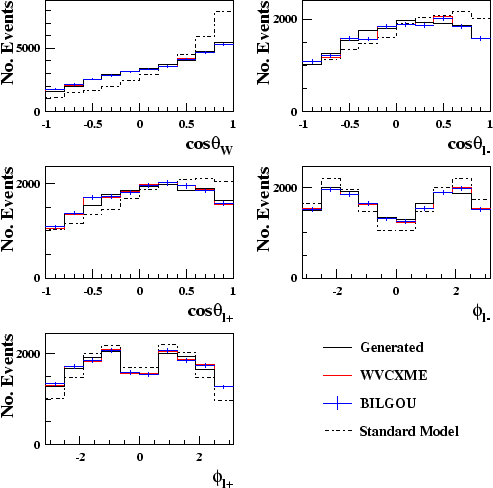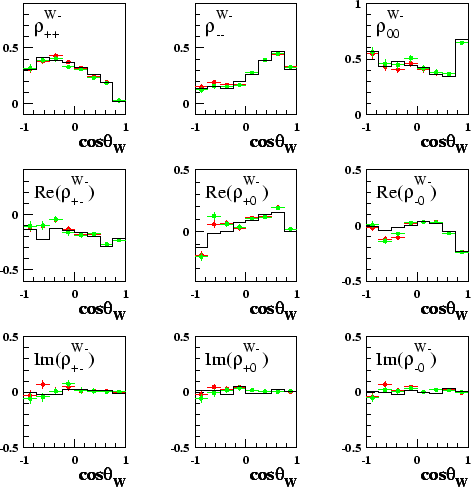For any Monte Carlo event a probability for it occurring, i.e. it's normalised cross-section, can be calculated from the square of the amplitude for this event. The probability can be calculated of it being a Standard Model event or an event in the presence of an anomalous coupling. The ratio of these two probabilities can be used to reweight a set of Standard Model events into a sample corresponding to the non-Standard Model anomalous coupling.
The WVCXME [100] program was developed from the EXCALIBUR four-fermion Monte Carlo generator. It uses the matrix elements from the generator program to calculate the amplitude squared. All it needs to know is the four-vectors of the four-fermions in the event and then it can calculate the amplitude squared for the Standard Model or with an anomalous coupling present. The generator includes all the features discussed in section 5.2.1. EXCALIBUR is a four-fermion generator, so WVCXME also takes into account the non-CC03 events that are sensitive to TGCs, and also the interference between the four-fermion final states.
An example
of the relevant angles for the SDM analysis calculated from a fully detector
simulated Standard Model four-fermion EXCALIBUR
sample of Monte Carlo events, that have been
reweighted to a sample with
![]()
![]() , is shown in
figure 6.2. Also shown on the same figure are the angles
calculated from a fully detector simulated sample of EXCALIBUR Monte Carlo
events
that were generated with a coupling of
, is shown in
figure 6.2. Also shown on the same figure are the angles
calculated from a fully detector simulated sample of EXCALIBUR Monte Carlo
events
that were generated with a coupling of
![]()
![]() . The angles from the
reweighted sample agree well with those from the sample generated with the
anomalous coupling.
. The angles from the
reweighted sample agree well with those from the sample generated with the
anomalous coupling.
 |
EXCALIBUR, and thus WVCXME, only contains the CP-conserving couplings, so this technique cannot be employed to produce samples of Monte Carlo with CP-violating couplings. However a similar reweighting technique can be used to make samples of Monte Carlo with CP-violating couplings using a different method to calculate the weights.
The analytical expression of the 5-fold differential cross-section for the CC03 events, given by equation 3.27, can be used to calculate weights for the W-pair events within a Monte Carlo sample. It does not contain any of the add-ons that WVCXME has, such as accounting for the finite W width, and it can only calculate weights for the CC03 events in the four-fermion sample. However, within these limitations, as it contains all 14 anomalous couplings, it can be used to calculate weights for CP-violating couplings.
ISR can be accounted for by using the generated four-vectors of the four-fermions
to boost the input angles, used in calculating the weight, back into the true
centre-of-mass frame. Using equation 3.27, the Standard Model
cross-section for a Standard Model Monte Carlo event (![]() ) can be calculated
and also the cross-section for an anomalous coupling (
) can be calculated
and also the cross-section for an anomalous coupling (![]() ) being
present. The ratio of these two is
then the equivalent weight, shown in equation 6.9. In equation 6.9
) being
present. The ratio of these two is
then the equivalent weight, shown in equation 6.9. In equation 6.9
![]() represents the set of five angles;
represents the set of five angles;
![]() ,
,
![]() ,
,
![]() ,
,
![]() and
and
![]() .
.
As this method is based on analytical expressions from papers by Bilenkii and Gounaris, the reweighting scheme is known as the BILGOU reweighting scheme.
The angular distributions for a Standard Model EXCALIBUR Monte Carlo sample,
reweighted to an anomalous coupling of
![]()
![]() , using the BILGOU reweighting
scheme are shown in
figure 6.2. The distributions agree
well with both those generated with a coupling of
, using the BILGOU reweighting
scheme are shown in
figure 6.2. The distributions agree
well with both those generated with a coupling of
![]()
![]() and those
reweighted using WVCXME.
and those
reweighted using WVCXME.
The single W SDM elements extracted from a sample of fully detector simulated
EXCALIBUR Monte Carlo generated with an anomalous coupling of
![]()
![]() are shown
in figure 6.3. Also shown are the SDM elements extracted
from a Standard Model sample which has been reweighted using both methods
of reweighting. Good agreement is seen in most cases.
are shown
in figure 6.3. Also shown are the SDM elements extracted
from a Standard Model sample which has been reweighted using both methods
of reweighting. Good agreement is seen in most cases.
 |